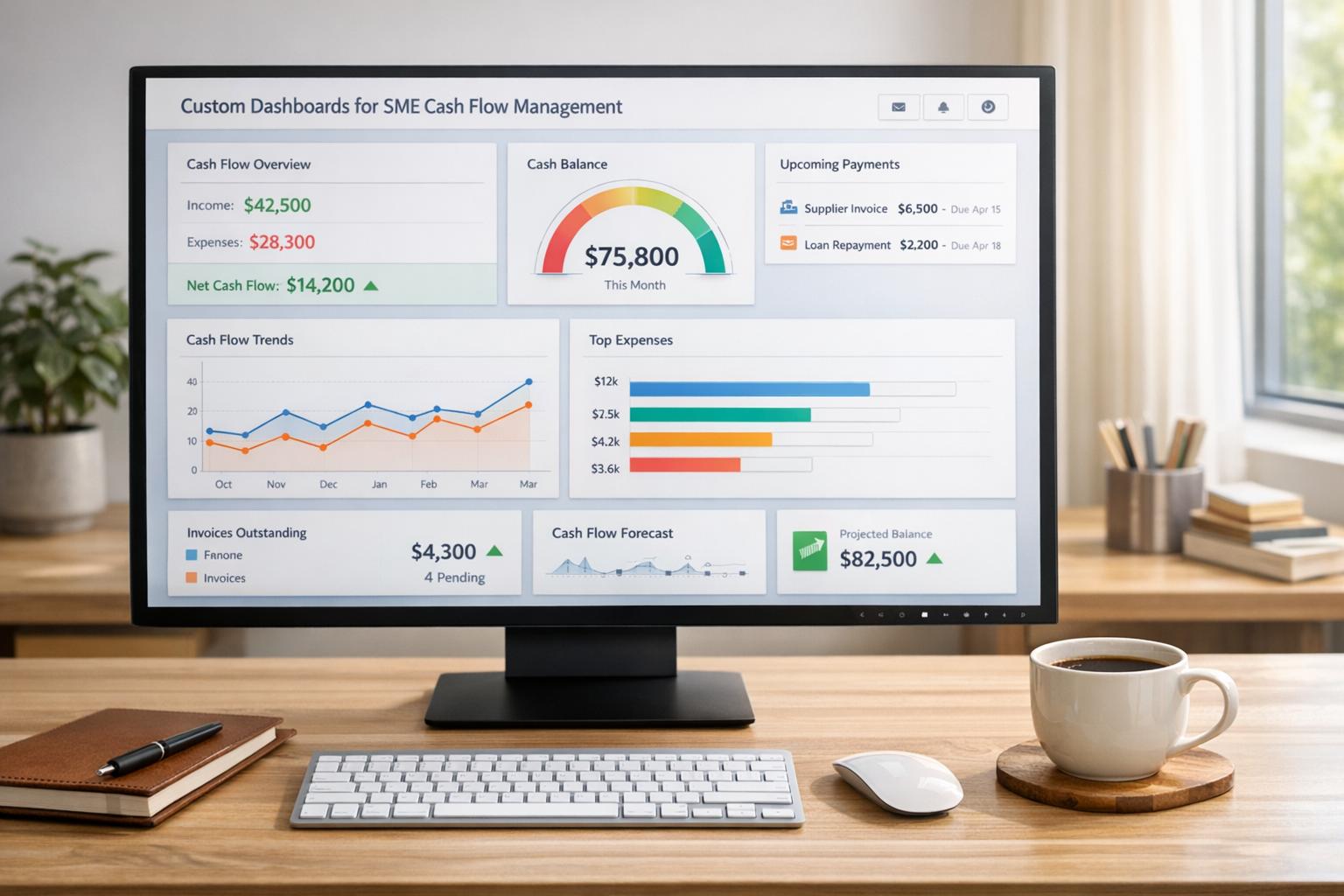Debt Monitoring for SaaS Companies

Managing debt is a critical challenge for SaaS companies, where upfront costs like customer acquisition and infrastructure often clash with the slow trickle of subscription revenue. Here’s what you need to know to stay on top of your finances:
-
Key Metrics to Watch:
- Debt-to-Equity Ratio: Measures the balance between borrowed funds and equity.
- Net Debt-to-ARR Ratio: Tracks debt sustainability against recurring revenue.
- Debt Service Coverage Ratio (DSCR): Ensures income can cover debt payments.
-
Practical Solutions:
- Build and maintain a detailed debt schedule.
- Automate debt tracking for real-time insights.
- Use forecasting to predict debt impacts and plan for growth.
-
Common Challenges:
- Cash Flow Gaps: Align debt payments with subscription revenue cycles.
- Growth vs. Debt: Balance expansion goals with financial obligations.
- Data Accuracy: Use automation to ensure reliable financial data.
SaaS Debt Monitoring Metrics
For SaaS companies, keeping an eye on debt metrics is essential to maintain financial stability and support growth. These metrics help decision-makers evaluate borrowing, manage cash flow, and understand financial leverage.
Debt-to-Equity (D/E) Ratio
Balancing debt and equity is especially important for businesses with recurring revenue. The D/E ratio is calculated as:
D/E Ratio = Total Debt / Total Shareholders' Equity
Since benchmarks can differ based on a company's growth stage and market conditions, it's important to set a target range that fits your specific goals.
Net Debt-to-ARR Ratio
This metric is tailored for SaaS companies, comparing net debt (total debt minus cash) to Annual Recurring Revenue (ARR). It measures how sustainable debt levels are in relation to predictable subscription revenue. The formula is:
Net Debt-to-ARR = (Total Debt - Cash) / Annual Recurring Revenue
Use this ratio to ensure your debt aligns with your financial strategy and growth plans.
Debt Service Coverage Ratio (DSCR)
DSCR reflects a company's ability to handle its debt obligations. It's calculated as:
DSCR = Net Operating Income / Total Debt Service
A DSCR above 1 indicates the company generates enough income to cover its debt payments. However, the ideal value can vary depending on industry trends and specific business needs.
SaaS Debt Management Methods
Managing debt effectively is crucial for maintaining financial stability as your company grows. Combining traditional strategies with modern technology can help keep debt levels in check and support long-term expansion.
Building a Debt Schedule
A detailed debt schedule is essential for tracking obligations and planning payments. It should include:
- Principal amounts
- Payment schedules
- Interest rates
- Covenant requirements
- Revenue timing
- Cash flow projections
Tools like Phoenix Strategy Group's Integrated Financial Model can make this process smoother. By syncing real-time financial data with payment obligations, companies can stay ahead of debt service requirements while ensuring they have enough cash on hand.
Debt Tracking Automation
Automation is transforming how SaaS companies monitor and manage debt. Automated systems not only save time but also improve accuracy in tracking important debt metrics.
Here’s how automation can help:
- Real-time invoice processing and payment tracking
- Automated payment collection and reconciliation
- Monitoring covenant compliance
- Custom alerts for payment deadlines
- Seamless integration with accounting and financial planning tools
These systems make it easier to collect and analyze data, helping companies predict the impact of debt more precisely.
Debt Impact Forecasting
Once you’ve set up a solid debt schedule and automated tracking, the next step is forecasting. Accurate forecasting allows you to plan for the future by evaluating how debt affects your business. Here's what to focus on:
- Review historical performance to identify cash flow patterns and set practical goals.
- Build multiple scenarios to see how different debt levels could influence:
- Cash flow stability
- Ability to invest in growth
- Compliance with covenants
- Operational flexibility
- Update forecasts weekly to respond quickly to market changes.
sbb-itb-e766981
Common Debt Management Issues
SaaS companies often encounter challenges in managing debt that require specific solutions to maintain steady growth.
Cash Flow Gaps
One common issue is the mismatch between debt payment schedules and the timing of subscription revenue. Subscription payments usually trickle in throughout the month, while debt payments have fixed deadlines. This timing difference can lead to cash flow shortages.
Here are some ways to tackle this issue:
- Negotiate payment terms that better align with your revenue cycle.
- Keep a cash reserve covering at least 3-4 months of debt payments.
- Use automated tools to track payments and forecast potential shortfalls.
- Set up a revolving credit line to handle short-term cash flow gaps.
Growth vs Debt Trade-offs
Finding the right balance between funding growth and managing debt can be tricky. Expanding too quickly with borrowed funds might strain finances, while being overly cautious could limit growth opportunities.
To navigate this:
- Develop detailed financial forecasts that include both growth plans and debt obligations.
- Set and monitor KPIs to measure how debt impacts your company’s performance.
- Combine finance and revenue data for more informed decision-making.
- Regularly review debt covenants to ensure compliance as you pursue growth.
"As our fractional CFO, they accomplished more in six months than our last two full-time CFOs combined. If you're looking for unparalleled financial strategy and integration, hiring PSG is one of the best decisions you can make." - David Darmstandler, Co-CEO, DataPath
Alongside balancing these priorities, maintaining accurate financial data is essential.
Data Quality Control
Inaccurate financial data can lead to poor decisions and compliance risks. Ensuring high-quality data is critical for effective debt management.
Steps to improve data accuracy include:
- Use automated systems to minimize manual data entry errors.
- Establish clear, standardized processes for validating financial data.
- Assign responsibility for data accuracy to specific team members.
- Implement ETL pipelines and data warehouses for consolidated reporting.
- Conduct weekly reviews of data quality with key stakeholders.
A strong data quality system should address the following:
| Component | Purpose | Key Features |
|---|---|---|
| Data Collection | Ensure accurate input | Automated validation |
| Processing | Maintain data integrity | ETL pipelines |
| Reporting | Support informed decisions | Real-time dashboards |
| Review | Verify accuracy | Weekly checks |
Conclusion
Managing debt effectively is a cornerstone of financial stability, especially during periods of growth. By focusing on key metrics and sound management practices, businesses can develop a clear and actionable approach.
Here are four essential practices for effective debt monitoring:
- Keep financial data accurate with the help of automated systems.
- Align debt payments with revenue cycles for smoother cash flow.
- Use forecasting models to anticipate future financial needs.
- Define metrics to measure the impact of debt on your business.
When applied together, these steps can help SaaS companies manage debt while scaling successfully.
Phoenix Strategy Group has proven expertise in this area, having supported over 240 portfolio companies and facilitated more than $200 million in funding in just the past year. Their approach combines financial and revenue operations to help SaaS businesses grow sustainably while keeping debt under control.
For SaaS companies ready to improve their debt management, the focus should be on systems that offer real-time financial insights and maintain high-quality data. As ABLEMKR's CEO Patrick Wallain puts it:
"If you want to sleep better at night, hire Phoenix Strategy Group."




